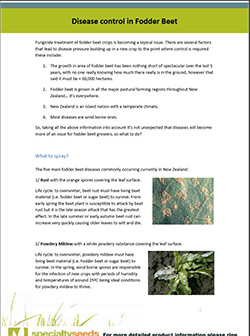 |
|
|
|
Issue 82 / Summer / February 2017
Hi [firstname]
 Welcome to the February edition of the SeedData newsletter, and thanks for taking the time to have a quick read.
Welcome to the February edition of the SeedData newsletter, and thanks for taking the time to have a quick read.
As I write this newsletter, firefighters in the Hastings and Christchurch regions are busy trying to keep ahead of serious fires throughout their respective regions.
Our thoughts are with these hard-working teams. They're doing a great job keeping our communities safe and most are doing so on a voluntary basis.
It does however make the point at just how quickly we can go from a land of milk and honey, as our Spring and early Summers were, to being very dry so quickly!
In this month's newsletter, we will look at a couple of subjects that are of interest to me; spraying fodder beet with a fungicides and the growing popularity of crops that are used to build up soil condition.
Please browse these topics below:

Disease control in fodderbeet.

February can be a busy month for fodder beet growers as fertiliser need to be applied, boulters pulled out and where ever possible, irrigation.
It's very pleasing to see the crops of fodder beet in my area looking good at this stage.
The rain we had during late Spring / early Summer and the warm and sunny conditions we currently are experiencing have all added up to the crops looking better now than they did at this time last season.
Over the last two years we are starting to see some disease pressure come on our crops around this time of the year and so fungicide treatment of fodder beet crops is becoming a topical issue.
There are several factors that lead to disease pressure building up in a new crop to the point where control is required. These include:
- The growth in area of fodder beet has been nothing short of spectacular over the last 5 years, with no one really knowing how much there really is in the ground, however that said it must be 60,000+ hectares
- Fodder beet is grown in all the major pastural farming regions throughout New Zealand ...its everywhere!
- New Zealand is an Island nation with a temperate climate.
- Most diseases are wind borne ones.
So, taking all the above information into account it's not unexpected that diseases will become more of an issue for fodder beet growers, so what to do?
If you are interested in more please check out the Disease control in fodderbeet download below to see more information on what weeds to spray, when to spray, and what to spray it with.
Download Link: Download the Specialty Seeds Disease control in fodderbeet download.
Website Link: Check out the Specialty Seeds Downloads page.
Contact Link: Contact Specialty Seeds if you have any other questions.
Back to top
 New Zealand at the fore of cover crop development.
New Zealand at the fore of cover crop development.

Historically, the use of cover crops in New Zealand has been limited, in the main, to areas involved with intensive maize or market vegetable production.
Worldwide the use of cover crops is very big business indeed particularly in the big crop producing regions of the world.
During the last few years there has been a small but growing interest in the use of them in New Zealand.
It was pleasing to see in a recent article about a New Zealand company that is at the fore in developing what could be a game changer in this market, with their new 'Smart Radish'.
The fundamental reason’s cover crops are used include management of soil erosion, improving soil quality, soil fertility and add to biodiversity of agroecosystem.
Smart Radish
Smart Radish will be coming onto the market in fully during 2018 after seven years of research and development between the New Zealand based Norwest Seeds Ltd and Plant Research NZ.
Smart Radish was developed/ bred with the aim to increase nutrient recycling and improve soil health.
As there has been little research into developing products specifically targeting this huge market, Smart Radish will find a niche quickly.
Smart Radish was bred to establish rapidly and has 'pull down' root / bulb which helps break up compacted soils.
The roots have been selected to have fibrous lateral roots that that can better feed from the soil, while the leaves act like solar panels as well as giving more ground cover and/or grazing for those interested in feeding livestock.
While further work is ongoing, Smart Radish results to date are very encouraging and when Smart Radish is compared to the typically used sprouting radish types, it is believed that Smart Radish can achieve in a year, what now takes two years.
NorWest seeds says Smart Radish is a completely different radish type above and below the ground.
Should you want some more information on Smart Radish please feel free to contact us
Contact Link: Contact Specialty Seeds if you have any questions.
Back to top


As always, we hope this issue has been of some value to you. If you have a comment on this newsletter or anything on our website, please give us a call on our Freephone: 0800 727 8873, send us an email at: mail@specseed.co.nz.
Kind Regards

Stephen Finch & David Percival
Specialty Seeds - New Zealand
|
|
|
|
 |
|
|

|
If you are having trouble viewing this email, .
If you would like to be removed from this newsletter please click here to
|
